Abstract
OBJECTIVE: The aim of this study was to identify differences in rectal wall contractility between healthy volunteers and patients with chronic severe constipation. SUMMARY BACKGROUND DATA: Whether motor function of the rectum contributes to slow-transit constipation is unknown. Measurements of rectal contractility have been performed traditionally with perfused catheters or microtransducers. The rectal barostat is a new technique that quantifies the volume of air within an infinitely compliant intrarectal bag maintained at constant pressure; decreases in bag volume therefore reflect increases in rectal muscular contractility (tone). Increases in volume reflect decreased contractility. METHODS: Fifteen healthy volunteers (ten women and five men; mean age, 36 years) and eight patients (seven women and one man; mean age, 44 years) were studied. Barostat recordings were made for 1 hour before and after a meal. Randomly, neostigmine (0.5 mg) or glucagon (1 unit) was then given intravenously. After 1 hour, the other medication was given. RESULTS: The fasting rectal volume was similar in the patient and control groups (113 +/- 7 mL vs. 103 +/- 4 mL, respectively; p > 0.05). Compared with controls, constipated patients had a significantly lower reduction in rectal volume after a meal (constipated, 35 +/- 8% vs. controls, 65 +/- 7%; p < 0.05) and after neostigmine administration (constipated, 39 +/- 6% vs. controls, 58 +/- 6%; p < 0.05). Moreover, constipated patients had a smaller increase in rectal volume after glucagon administration than did controls (28 +/- 6% vs. 64 +/- 18%, respectively; p < 0.05. CONCLUSIONS: Changes in rectal wall contractility in response to feeding, a cholinergic agonist, and a smooth muscle relaxant were decreased in constipated patients. These findings suggest that an abnormality of rectal muscular wall contractility is present in constipated patients.
Full text
PDF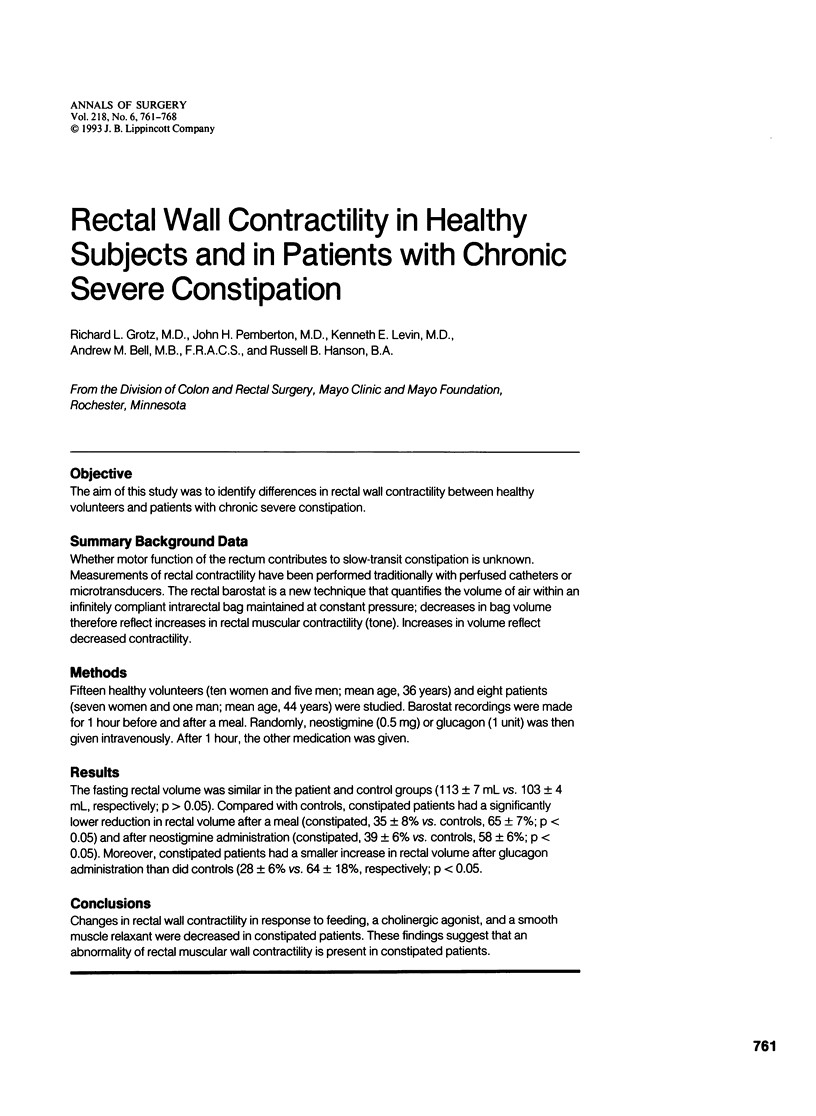


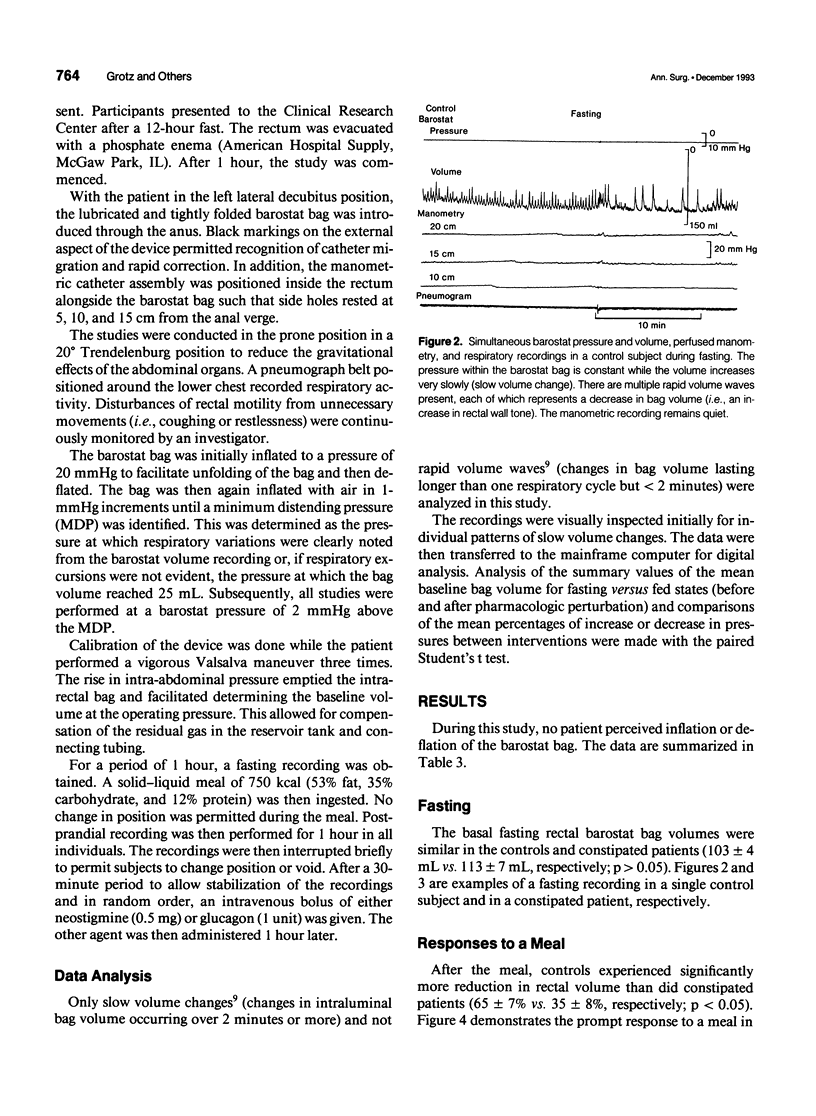
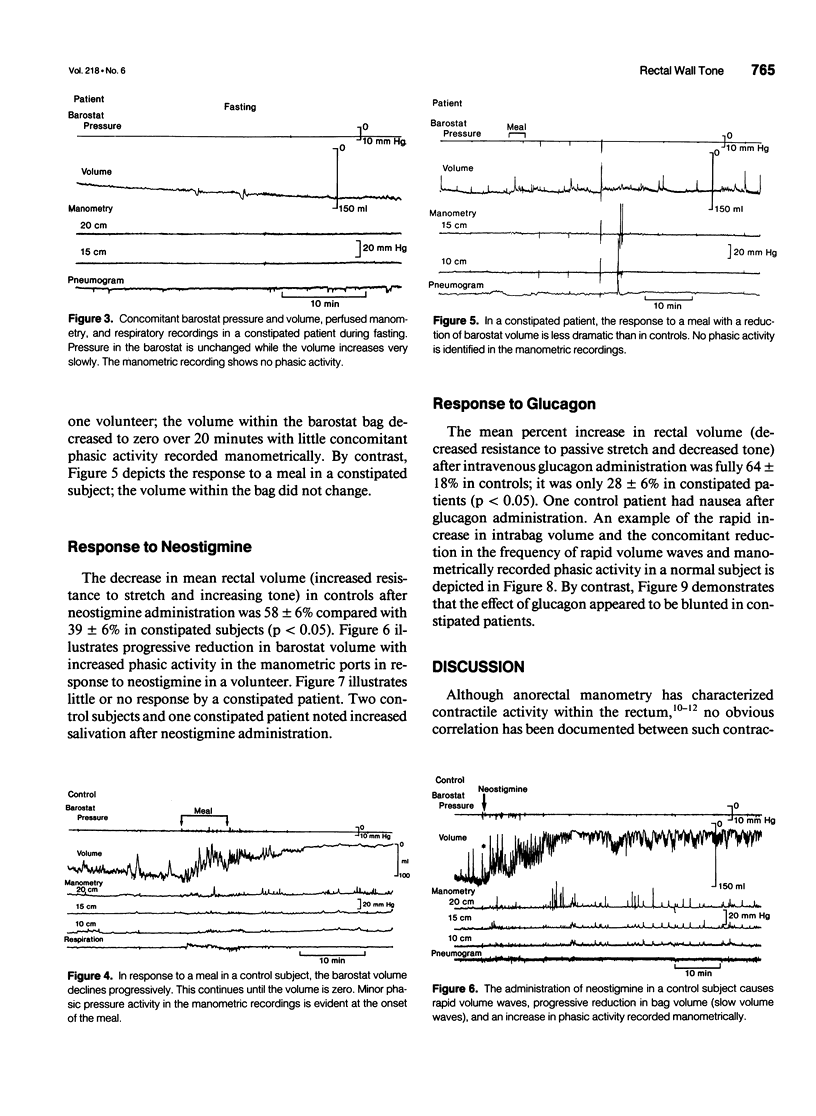
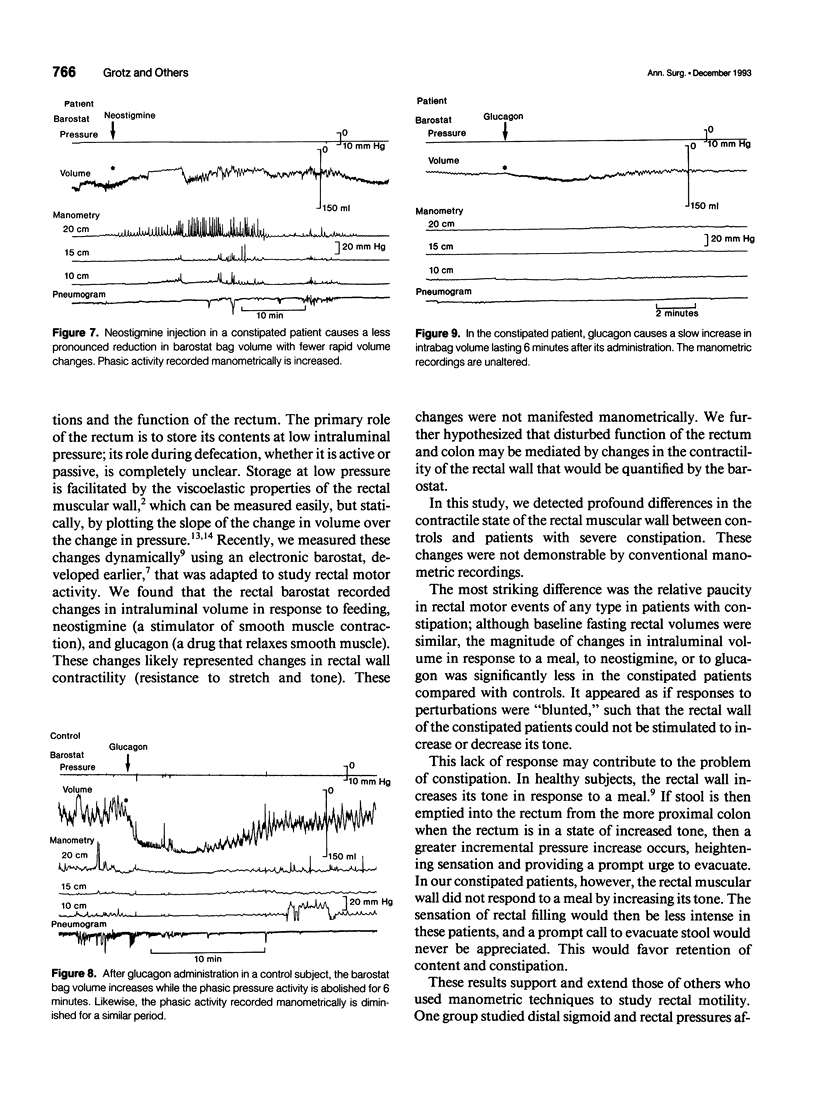
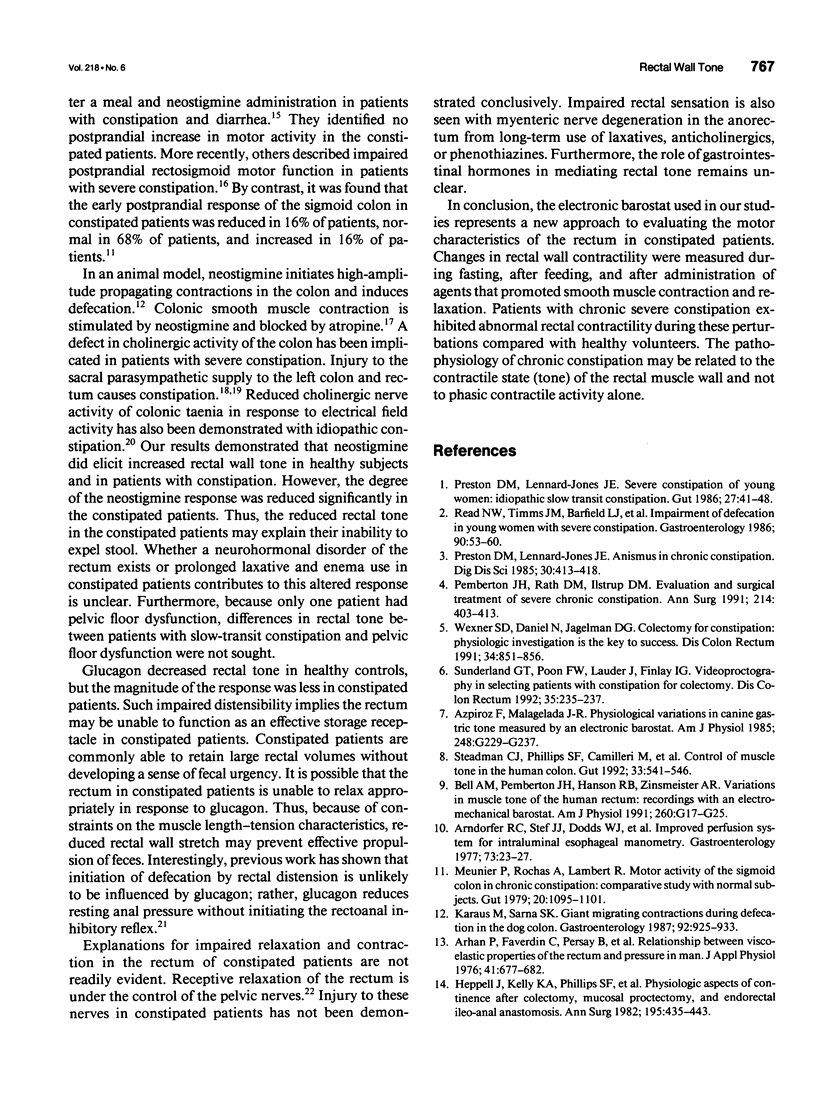
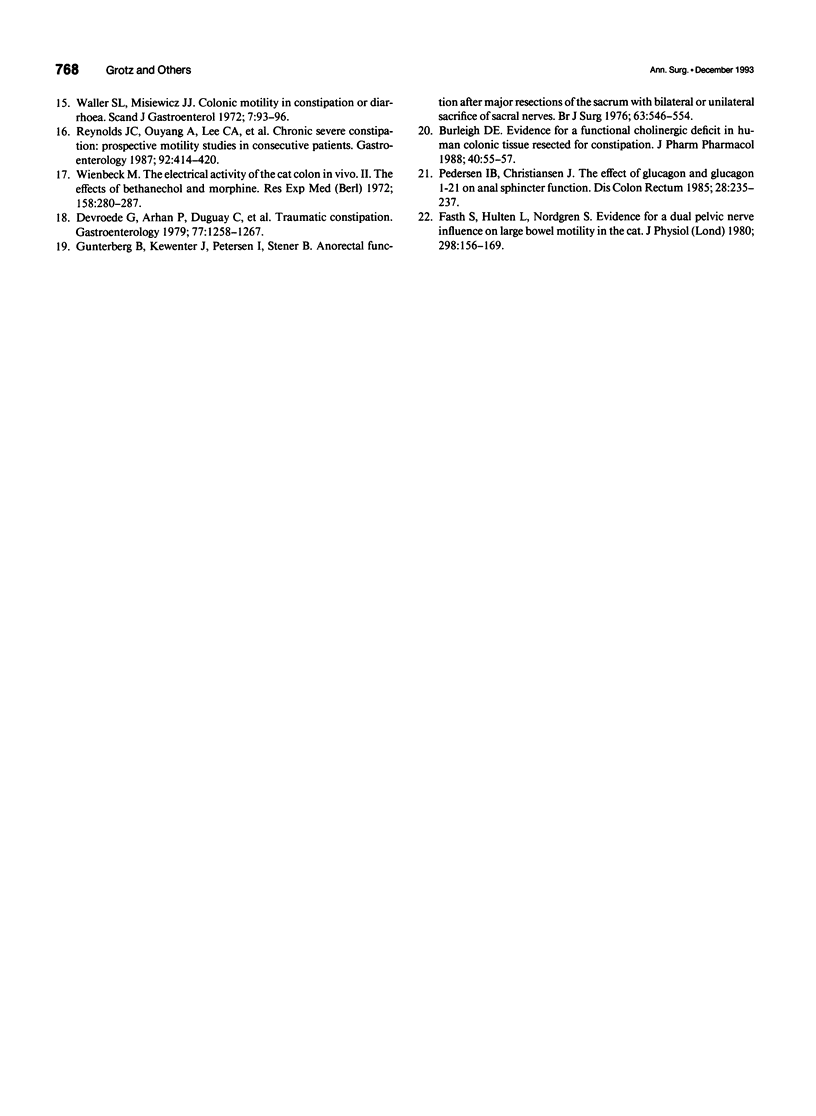
Selected References
These references are in PubMed. This may not be the complete list of references from this article.
- Arhan P., Faverdin C., Persoz B., Devroede G., Dubois F., Dornic C., Pellerin D. Relationship between viscoelastic properties of the rectum and anal pressure in man. J Appl Physiol. 1976 Nov;41(5 Pt 1):677–682. doi: 10.1152/jappl.1976.41.5.677. [DOI] [PubMed] [Google Scholar]
- Arndorfer R. C., Stef J. J., Dodds W. J., Linehan J. H., Hogan W. J. Improved infusion system for intraluminal esophageal manometry. Gastroenterology. 1977 Jul;73(1):23–27. [PubMed] [Google Scholar]
- Azpiroz F., Malagelada J. R. Physiological variations in canine gastric tone measured by an electronic barostat. Am J Physiol. 1985 Feb;248(2 Pt 1):G229–G237. doi: 10.1152/ajpgi.1985.248.2.G229. [DOI] [PubMed] [Google Scholar]
- Burleigh D. E. Evidence for a functional cholinergic deficit in human colonic tissue resected for constipation. J Pharm Pharmacol. 1988 Jan;40(1):55–57. doi: 10.1111/j.2042-7158.1988.tb05151.x. [DOI] [PubMed] [Google Scholar]
- Devroede G., Arhan P., Duguay C., Tétreault L., Akoury H., Perey B. Traumatic constipation. Gastroenterology. 1979 Dec;77(6):1258–1267. [PubMed] [Google Scholar]
- Fasth S., Hultén L., Nordgren S. Evidence for a dual pelvic nerve influence on large bowel motility in the cat. J Physiol. 1980 Jan;298:159–169. doi: 10.1113/jphysiol.1980.sp013073. [DOI] [PMC free article] [PubMed] [Google Scholar]
- Gunterberg B., Kewenter J., Petersén I., Stener B. Anorectal function after major resections of the sacrum with bilateral or unilateral sacrifice of sacral nerves. Br J Surg. 1976 Jul;63(7):546–554. doi: 10.1002/bjs.1800630713. [DOI] [PubMed] [Google Scholar]
- Heppell J., Kelly K. A., Phillips S. F., Beart R. W., Jr, Telander R. L., Perrault J. Physiologic aspects of continence after colectomy, mucosal proctectomy, and endorectal ileo-anal anastomosis. Ann Surg. 1982 Apr;195(4):435–443. doi: 10.1097/00000658-198204000-00009. [DOI] [PMC free article] [PubMed] [Google Scholar]
- Karaus M., Sarna S. K. Giant migrating contractions during defecation in the dog colon. Gastroenterology. 1987 Apr;92(4):925–933. doi: 10.1016/0016-5085(87)90966-8. [DOI] [PubMed] [Google Scholar]
- Meunier P., Rochas A., Lambert R. Motor activity of the sigmoid colon in chronic constipation: comparative study with normal subjects. Gut. 1979 Dec;20(12):1095–1101. doi: 10.1136/gut.20.12.1095. [DOI] [PMC free article] [PubMed] [Google Scholar]
- Pedersen I. K., Christiansen J. The effect of glucagon and glucagon 1-21 on anal sphincter function. Dis Colon Rectum. 1985 Apr;28(4):235–237. doi: 10.1007/BF02554041. [DOI] [PubMed] [Google Scholar]
- Pemberton J. H., Rath D. M., Ilstrup D. M. Evaluation and surgical treatment of severe chronic constipation. Ann Surg. 1991 Oct;214(4):403–413. doi: 10.1097/00000658-199110000-00005. [DOI] [PMC free article] [PubMed] [Google Scholar]
- Preston D. M., Lennard-Jones J. E. Anismus in chronic constipation. Dig Dis Sci. 1985 May;30(5):413–418. doi: 10.1007/BF01318172. [DOI] [PubMed] [Google Scholar]
- Preston D. M., Lennard-Jones J. E. Severe chronic constipation of young women: 'idiopathic slow transit constipation'. Gut. 1986 Jan;27(1):41–48. doi: 10.1136/gut.27.1.41. [DOI] [PMC free article] [PubMed] [Google Scholar]
- Read N. W., Timms J. M., Barfield L. J., Donnelly T. C., Bannister J. J. Impairment of defecation in young women with severe constipation. Gastroenterology. 1986 Jan;90(1):53–60. doi: 10.1016/0016-5085(86)90074-0. [DOI] [PubMed] [Google Scholar]
- Reynolds J. C., Ouyang A., Lee C. A., Baker L., Sunshine A. G., Cohen S. Chronic severe constipation. Prospective motility studies in 25 consecutive patients. Gastroenterology. 1987 Feb;92(2):414–420. [PubMed] [Google Scholar]
- Steadman C. J., Phillips S. F., Camilleri M., Talley N. J., Haddad A., Hanson R. Control of muscle tone in the human colon. Gut. 1992 Apr;33(4):541–546. doi: 10.1136/gut.33.4.541. [DOI] [PMC free article] [PubMed] [Google Scholar]
- Sunderland G. T., Poon F. W., Lauder J., Finlay I. G. Videoproctography in selecting patients with constipation for colectomy. Dis Colon Rectum. 1992 Mar;35(3):235–237. doi: 10.1007/BF02051013. [DOI] [PubMed] [Google Scholar]
- Waller S. L., Misiewicz J. J. Colonic motility in constipation or diarrhoea. Scand J Gastroenterol. 1972;7(1):93–96. doi: 10.3109/00365527209180743. [DOI] [PubMed] [Google Scholar]
- Wexner S. D., Daniel N., Jagelman D. G. Colectomy for constipation: physiologic investigation is the key to success. Dis Colon Rectum. 1991 Oct;34(10):851–856. doi: 10.1007/BF02049695. [DOI] [PubMed] [Google Scholar]
- Wienbeck M. The electrical activity of the cat colon in vivo. II. The effects of bethanechol and morphine. Res Exp Med (Berl) 1972;158(4):280–287. doi: 10.1007/BF01852211. [DOI] [PubMed] [Google Scholar]


